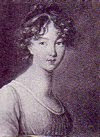
This pattern is from The Knitting Teacher’s Assistant Designed for the Use of the National Girls’ School, printed in 1817. The facsimile edition, which I used, is available from Robin Stokes (www.robinstokes.com) In the introduction to the facsimile edition, Ms. Stokes writes that she believes this instruction book is the earliest printed pattern currently available. As of May, 2011, there seems not to be anything earlier that has survived in English. Ms. Stokes also writes that “The original purpose of this book was a charitable effort to teach the poor to knit for extra income.”
There are patterns for five sizes of stockings and three sizes of socks with a “scale” (sizing/stitch chart) at the end for both stockings and socks. The pattern, itself, is presented in a question and answer format, e.g., “Q. How do you cast on the stitches? / A. I take the worsted that is on the ball in the right hand…” The stocking is not difficult to knit and the older knitting language is easily interpreted.
I knit the smallest size stocking. There are also patterns for a man's stocking and socks, respectively, knit in lambswool.
In keeping with the times, there is no tension/gauge or needle size stated although “coarse worsted and large needles” are suggested. I followed these instructions by using 3.25mm/3US needles which are larger than the usual sizes I use for reproduction stockings. I also chose Harrisville Designs’ Shetland (two ply) as it is twice the thickness of the usual finer weight wool I use for 18th/19th century stocking; it gave me 7 ½ stitches to the inch. I adore knitting with this wool and, in this case, the gorgeous Marigold color was so bright and cheerful, a definite antidote to Second Stocking Syndrome.
There is no welting or rows or panels of garter stitchs. "Six rounds ribbed" (italics in the original pattern) of "three stitches plan and turning three" (knit three, purl three) instead. Do the italics stress the departure from the older style of stocking top? The narrowing or decreases were knit two together on the right side of the turn or seam stitch, right leaning as is typical of the era, and on the left of the seam stitch, a knit one, pass the next (unknitted) stitch over the knitted stitch. A single knitted stitch, as usual (although I have seen two), was left on either side of the seam stitch on the leg.
The foot had and extra stitch knit “in the loop” either side of the instep “to prevent holes in the corners.” There were also instructions for widening the “heel sides,” as is evident in the photographs from the outward slope on the bottom of the flattened feet.
The toe decreases are not the usual every alternate row but are done in different numerical sequences.
When starting a new ball of wool, it is suggested that the "end of the worsted" be "knit in with the first three stitches."
I followed the exact directions throughout (which is unusual for me) and thought that the leg was a bit short in proportion to the size of the foot. I am 5’3” and have legs in proportion to that height but the stockings only come up to my knee and do not go over them at all. On the other hand, or foot, so to speak, my shoe size is 37 ½ mm/7US, and the foot of this stocking is a good 2 ¾” longer than my foot. It is also a bit roomy on either side of my foot as a result of those added side heel stitches.
The final measurements for the stockings are 10 ¼” around the leg under the ribbing, 8” around the ankle, 10” around the widest part of the foot and 8" around the narrowest part of the foot, between the two sets of decreases. The stocking, from the top of the ribbing to the bottom of the heel measures 18 ½”.
I plan to make the socks, next, but will adjust and fit them more to my foot so I can wear them.















